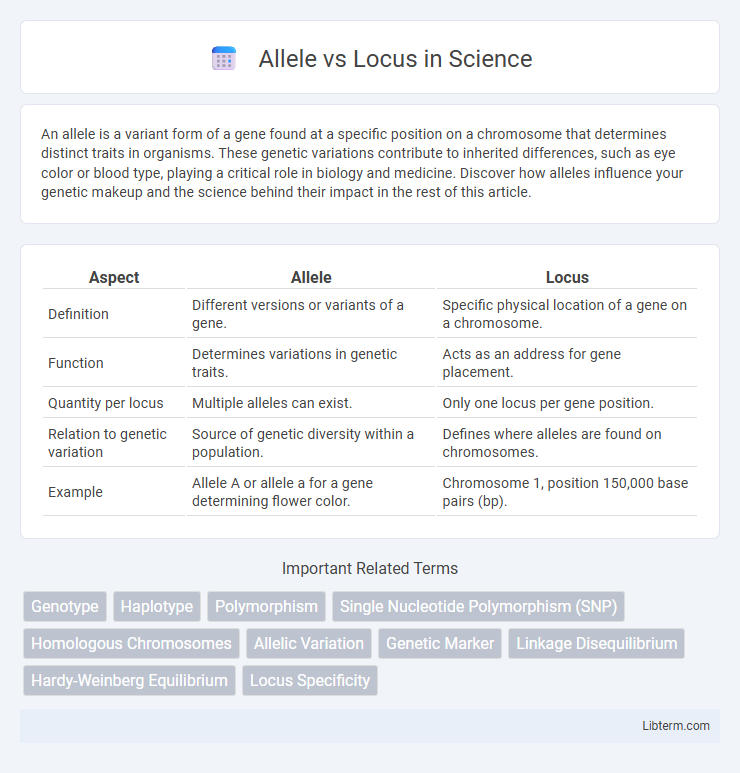An allele is a variant form of a gene found at a specific position on a chromosome that determines distinct traits in organisms. These genetic variations contribute to inherited differences, such as eye color or blood type, playing a critical role in biology and medicine. Discover how alleles influence your genetic makeup and the science behind their impact in the rest of this article.
Table of Comparison
| Aspect | Allele | Locus |
|---|---|---|
| Definition | Different versions or variants of a gene. | Specific physical location of a gene on a chromosome. |
| Function | Determines variations in genetic traits. | Acts as an address for gene placement. |
| Quantity per locus | Multiple alleles can exist. | Only one locus per gene position. |
| Relation to genetic variation | Source of genetic diversity within a population. | Defines where alleles are found on chromosomes. |
| Example | Allele A or allele a for a gene determining flower color. | Chromosome 1, position 150,000 base pairs (bp). |
Understanding Alleles: Definition and Role
An allele is a specific variant of a gene located at a particular position on a chromosome, known as a locus. Each individual inherits two alleles for each gene, one from each parent, which determine distinct traits or characteristics. Understanding alleles is crucial for studying genetic variation, inheritance patterns, and how different traits are expressed in organisms.
What is a Locus? Key Genetic Terminology
A locus is a specific, fixed position on a chromosome where a particular gene or genetic marker resides, serving as the physical location for one or more alleles. Understanding the locus is crucial for interpreting genetic variation, as different alleles at the same locus can result in diverse traits or disease susceptibilities. This key genetic terminology facilitates mapping genes and studying inheritance patterns across populations.
Allele vs Locus: Core Differences Explained
An allele is a specific variant of a gene found at a particular position on a chromosome, while a locus refers to the fixed physical location or position of that gene on the chromosome. Alleles at a given locus can vary between individuals, contributing to genetic diversity and influencing traits and inheritance patterns. Understanding the distinction between allele and locus is crucial in genetics for mapping genes and studying variations linked to diseases or traits.
How Alleles and Loci Influence Genetic Variation
Alleles are different versions of a gene found at a specific locus on a chromosome, and their variation contributes significantly to genetic diversity within a population. Each locus represents a fixed position on a chromosome, where different alleles can exist, leading to phenotypic differences. The interaction of multiple alleles across various loci generates the complex genetic variation essential for evolution and adaptation.
Chromosomal Locations: Mapping Loci and Alleles
Loci represent specific, fixed positions on chromosomes where genes or genetic markers are located, serving as reference points for mapping genetic traits. Alleles are the variant forms of a gene that occupy these loci, contributing to genetic diversity within a population. Precise chromosomal mapping of loci and their corresponding alleles enables detailed analysis of genetic inheritance and the identification of gene function in various organisms.
Examples of Alleles at Specific Loci
Alleles are different versions of a gene found at a specific locus on a chromosome, such as the ABO blood group gene locus where the A, B, and O alleles determine blood type. At the HBB gene locus, responsible for encoding the beta-globin protein, common alleles include the normal allele and the sickle cell allele, which causes sickle cell anemia. Another example is the MC1R gene locus associated with pigmentation, where alleles influence variations in hair and skin color.
Importance of Allele-Locus Relationships in Inheritance
Alleles are variant forms of a gene located at specific positions called loci on a chromosome, crucial for determining genetic traits. The relationship between an allele and its locus is fundamental in inheritance as it dictates how traits are transmitted from parents to offspring through dominant, recessive, or co-dominant patterns. Understanding this allele-locus interaction enables accurate prediction of hereditary traits, genetic diversity, and the mechanisms behind genetic disorders.
Common Misconceptions: Allele vs Locus
Common misconceptions about allele and locus often confuse their biological definitions; an allele refers to one of multiple variant forms of a gene found at a specific position, while a locus represents the fixed position of a gene or DNA sequence on a chromosome. People mistakenly use allele and locus interchangeably, but locus is the physical location, and alleles are the variations present at that locus. Clarifying this distinction is critical for accurate interpretation of genetic inheritance and variation studies.
Applications in Genetic Research and Medicine
Alleles are variant forms of a gene found at a specific locus on a chromosome, crucial for understanding genetic diversity and inheritance patterns in research and medical diagnostics. Identifying specific alleles at loci enables targeted genetic testing, personalized medicine, and gene therapy development by linking variations to disease susceptibility or drug response. Advances in CRISPR and sequencing technologies rely heavily on precisely mapping alleles to loci, facilitating breakthroughs in treating genetic disorders and improving patient outcomes.
Summary Table: Allele and Locus Compared
An allele represents a specific variant of a gene located at a particular locus on a chromosome, with multiple alleles possible for one locus. A locus denotes the fixed position or location of a gene or DNA sequence on a chromosome, serving as the physical site where alleles are found. The key difference lies in locus being the physical address on the chromosome, while alleles are the distinct genetic variations that can exist at that locus.
Allele Infographic

 libterm.com
libterm.com